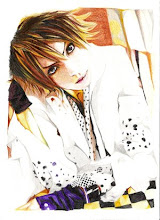I discovered DiTerlizzi's blog page and researched some information on the makings of his works, which can be found here http://diterlizzi.com/blog/?cat=12 I have also linked DiTerlizzi's website at the bottom of this page. The following is the essay I wrote about his work.
Tony DiTerlizzi was born in Los Angeles, California in 1969. He started drawing from a very young age, and created his first hand-made books based on his interests; dinosaurs and close investigations of insects. Throughout his childhood he continued to illustrate things of interest and his motivation and imagination grew. In 1981, he started to write and illustrate a field guide on fantastic creatures influenced by Jim Henson’s The Dark Crystal and the video game Dungeons and Dragons.
His fascination with fairytales and folklore led him to pursue a career as a children’s book illustrator after he graduated high school and has since pursued his dream as a professional illustrator.
After graduating from an art school in 1992, he began working for TSR (the publishers of Dungeons and Dragons) at the age of twenty-three. Apart from children’s books, his work contributed to the publishers of entertainment that had influenced him as a child, and he continued to draw fantastical images of mystical creatures, wizards and warriors for many years to date.
His talents were fully realized when he moved to New York in 1996, and he published his works under Simon & Schuster Books for Young Readers. Among his books were “Jimmy Zangwow’s Out-of-this-World Moon Pie Adventure” in 2000 (influenced by Windsor McKay and Norman Rockwell), “Ted” in 2001, and his version of “The Spider and The Fly” in 2003 (based on Mary Howitt’s 1829 poem) all of which had gained him many awards and recognition.
Perhaps his most famous work was for the Spiderwick Chronicles, where he collaborated with author Holly Black, who was a fellow fantasy and folklore enthusiast, and sketched a field guide for the series. The series had made him well-known among children readers
DiTerlizzi continues to spawn his creations with inspirations from other book writers with his later work on “Kenny and the Dragon”, influenced by Kenneth Grahame’s The Reluctant Dragon.
Recently he had collaborated with his wife Angela to produce “The Adventures of Meno” that had taken on a challenge of a completely different drawing style to his former works.
The following is one of DiTerlizzi’s field guide illustrations for the Spiderwick Chronicles. This one in particular highlights his fondness with magical beings and his choice of materials is very apparent in his works, usually ink drawings and watercolour washes to add character.
The style is very fine and subtle, with a distinctive cartoon-like feel to them. There is a gentle sense of childhood nostalgia and make-believe among his works, portraying mystical beings in their common natural features that can be imagined through a child’s mind.
DiTerlizzi manages to capture the imaginations of readers with his drawings, whether they are happy or frightful. Another example brings us to one of his drawings of monsters:
His drawing style can be very flexible. The mood of each illustration is changed completely with his choice of technique and colour hue (the dark colours in this piece gives a sense of threat and dirtiness, a very simple factor of provoking fear or disgust). The same drawing style applies; smooth, confident strokes of ink with a wash of colour.
Initially, he uses shading techniques for his non-coloured pieces. This further highlights the flexibility of his style. Among his plain ink drawings, they share similar appearances with each other in terms of line gradation (they have rough multiple strokes for the outline instead of the usual smooth lines for his watercolour drawings). An example of this is from one of his sketches in the book:
These images were scanned from a book. DiTerlizzi’s style of drawing remains distinctive, but the linear forces takes a unique route. He applies cross-hatchings to add depth and the outlines is broken and linked together with a series of small strokes.
More of my writing can be found in my sketchbook.









.jpg)

.jpg)


.jpg)

.jpg)







.jpg)



























